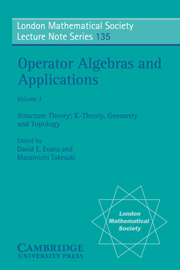Book contents
- Frontmatter
- Preface
- Contents
- UK-US Joint Seminar on Operator Algebras
- K-theory for discrete groups
- Comparison theory for simple C*-algebras
- Interpolation for multipliers
- Elliptic invariants and operator algebras: toroidal examples
- On multilinear double commutant theorems
- Loop spaces, cyclic homology and the Chern character
- The Weyl theorem and block decompositions
- Secondary invariants for elliptic operators and operator algebras
- Inverse limits of C*-algebras and applications
- Partitioning non-compact manifolds and the dual Toeplitz problem
- Cyclic cohomology of algebras of smooth functions on orbifolds
Loop spaces, cyclic homology and the Chern character
Published online by Cambridge University Press: 06 July 2010
- Frontmatter
- Preface
- Contents
- UK-US Joint Seminar on Operator Algebras
- K-theory for discrete groups
- Comparison theory for simple C*-algebras
- Interpolation for multipliers
- Elliptic invariants and operator algebras: toroidal examples
- On multilinear double commutant theorems
- Loop spaces, cyclic homology and the Chern character
- The Weyl theorem and block decompositions
- Secondary invariants for elliptic operators and operator algebras
- Inverse limits of C*-algebras and applications
- Partitioning non-compact manifolds and the dual Toeplitz problem
- Cyclic cohomology of algebras of smooth functions on orbifolds
Summary
INTRODUCTION The purpose of this note is to show how ideas from cyclic homology may be used to study geometrical and analytic properties of loop spaces. As such, the material in this note is not directly related to operator algebras; on the other hand it is not too distant either since cyclic homology is one of several good things to come out of the study of operator algebras in recent years.
Geometry and analysis on loop spaces is a subject of much current interest. One of the ideas which has emerged is the following, rather striking, point of view on the Chern character and the index theorem. Let X be a smooth compact oriented manifold with no boundary and let LX be the space of all smooth loops in X. This loop space is an infinite dimensional manifold, modelled on a Fréchet space. The circle T acts on LX by rotating loops; this action is smooth and the fixed point set is the manifold X regarded as the space of constant loops. We are principally interested in properties of the smooth T-manifold LX. The relation between the Chern character, the index theorem and loop spaces is given by the following facts. Let E be a complex vector bundle on X equipped with a connection ∇.
(a) There is a T-invariant, equivariantly closed differential form ω(E, ∇) on LX with the property that the restriction of ω(E, ∇) to X, the space of constant loops, is precisely the usual Chern character form, ch(E, ∇) = Trace(eF) where F is the curvature of ∇. This form ω(E, ∇) is Bismut's equivariant extension of the Chern character.
[…]
- Type
- Chapter
- Information
- Operator Algebras and Applications , pp. 95 - 108Publisher: Cambridge University PressPrint publication year: 1989
- 1
- Cited by



